May 7, 2023
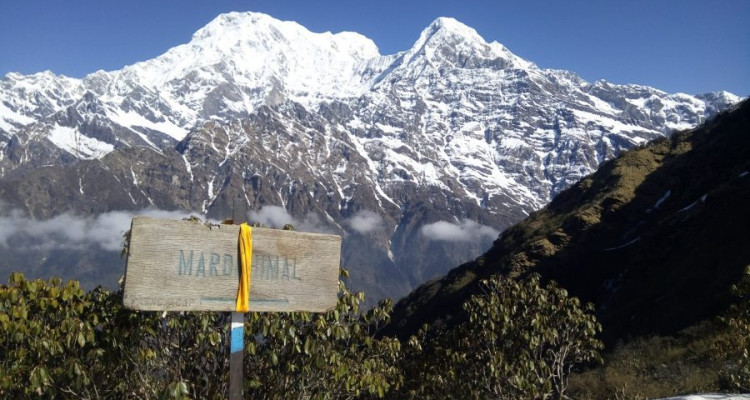
Mardi Himal Trek is a relatively new and off-the-beaten-path trekking route that has gained popularity in recent years. Located in the Annapurna region of Nepal, this trek takes you through pristine forests, and quaint villages, and offers stunning views of the Himalayan mountains.
October and November are some of the best months to do the Mardi Himal Trek. During this time, the weather is usually clear, dry, and sunny, with temperatures ranging from 10°C to 15°C during the day and dropping to around 0°C at night. This makes it the perfect time for trekking as the trails are not slippery, and the views are unobstructed by clouds.
The trek starts from the city of Pokhara, which is easily accessible by air or road from Kathmandu. From there, you will drive to Kande, the starting point of the trek, and begin your ascent through the lush forests of rhododendron, oak, and maple trees. You will pass through traditional Gurung and Magar villages, where you can experience the local culture and hospitality. The trek also offers the opportunity to witness the majestic Machhapuchhre (Fishtail) mountain, which is considered sacred by the locals.
The Mardi Himal Trek is a moderate trek, and the altitude gradually increases as you climb up to the Mardi Himal Base Camp at an elevation of 4,500 meters. This trek takes about 7-8 days to complete, depending on your pace and acclimatization. On the way to the base camp, you will witness breathtaking views of the Annapurna range, Dhaulagiri, and Machhapuchhre, among others.
One of the highlights of the Mardi Himal Trek is the High Camp, which is located at an altitude of 3,500 meters. From here, you can witness a panoramic view of the Himalayan mountains and enjoy the stunning sunrise and sunset views. The High Camp also provides an opportunity to explore the Mardi Himal Base Camp and take a closer look at the majestic mountain ranges.
In conclusion, the Mardi Himal Trek in October and November is a perfect blend of adventure, culture, and scenic beauty. The trek offers a unique experience of trekking in the Annapurna region, away from the crowds, and provides a chance to witness the beauty of the Himalayan mountains up close. With its moderate difficulty level and excellent weather conditions during this time, the Mardi Himal Trek is an excellent choice for both novice and experienced trekkers.
Preparing for the Mardi Himal trek requires physical fitness, proper gear, and some basic planning. Here are some tips to help you prepare for the trek:
October and November are considered the best months to do the Mardi Himal trek for several reasons:
Weather: During October and November, the weather in the Annapurna region is generally dry and stable, with sunny skies and mild temperatures. This makes it a comfortable time to trek, as the temperatures are not too hot during the day and not too cold at night. Additionally, there is less chance of rain or snow, which can make trekking more difficult and less enjoyable.
Views: October and November offer some of the best views of the mountains on the Mardi Himal trek. The skies are generally clear, providing unobstructed views of the surrounding peaks, including Annapurna, Dhaulagiri, and Machhapuchhre. The colorful autumn foliage also adds to the breathtaking scenery.
Crowds: October and November are the peak trekking season in Nepal, and many people choose to trek the Mardi Himal route during this time. While there will still be other trekkers on the trail, the crowds are generally more manageable than during the busiest months of the year.
Festivals: Nepal is known for its colorful festivals, and October and November offer a chance to experience some of these cultural celebrations while trekking. The biggest festival during this time is Dashain, which usually falls in October and involves several days of feasting and festivities.
Accessibility: The Mardi Himal trek starts and ends in Pokhara, which is easily accessible from Kathmandu by bus or plane. During October and November, the roads and transportation are generally more reliable, making it easier to get to and from the trailhead.
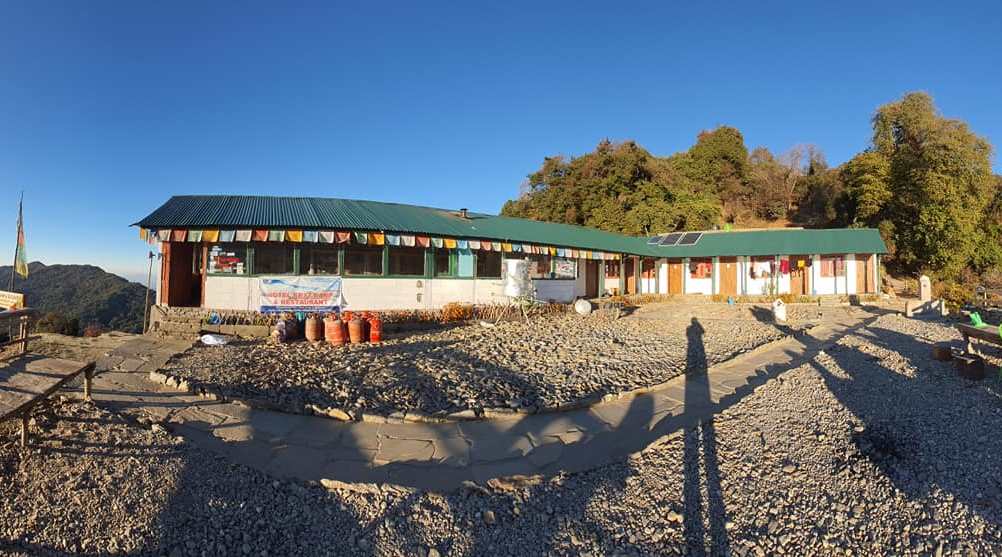
Rest camp mardi trek
The Mardi Himal trek offers some of the most stunning and breathtaking views in the Annapurna region of Nepal. Here are ten must-see views on the Mardi Himal trek during October and November:
Machhapuchhre Base Camp (3700m): The Machhapuchhre Base Camp offers a panoramic view of the towering Machhapuchhre (Fishtail) peak, which is one of the most distinctive mountains in Nepal. The views of the surrounding peaks and glaciers from here are simply stunning.
Mardi Himal Base Camp (4500m): The Mardi Himal Base Camp offers sweeping views of the Mardi Himal range, including Mardi Himal, Machhapuchhre, and Annapurna South. This is one of the highest points on the trek and provides a true sense of accomplishment.
High Camp (3550m): High Camp is located on a ridge above the tree line and offers sweeping views of the surrounding valleys and peaks. From here, trekkers can see the entire Annapurna range and the distant Dhaulagiri massif.
Low Camp (2970m): Low Camp is surrounded by dense forests and offers a unique perspective on the Himalayan foothills. Trekkers can enjoy panoramic views of the Annapurna and Machhapuchhre ranges from here.
Forests and Waterfalls: The Mardi Himal trek passes through lush forests of oak, rhododendron, and bamboo. Along the way, trekkers can enjoy beautiful waterfalls and streams that flow down from the mountains.
Sunrise at High Camp: The sunrise from High Camp is one of the most spectacular sights on the trek. The first rays of the sun illuminating the mountains is truly a once-in-a-lifetime experience.
Himalayan Wildlife: The forests of the Mardi Himal region are home to a variety of wildlife, including musk deer, Himalayan thar, and even snow leopards. Trekkers may also spot monkeys, birds, and butterflies along the way.
Cultural Experiences: The Mardi Himal trek passes through several traditional Gurung and Magar villages, where trekkers can experience the local culture and way of life. The colorful prayer flags, chortens, and mani walls along the way are also worth seeing.
Annapurna Sanctuary: The Mardi Himal trek passes through the Annapurna Sanctuary, a vast glacial basin surrounded by some of the tallest peaks in the world. The views of the towering mountains and glaciers from here are truly awe-inspiring.
Mardi Khola: The Mardi Khola is a beautiful river that flows through the valleys of the Mardi Himal region. Trekkers can enjoy the serene beauty of the river and the surrounding landscapes throughout the trek.
The best time to go on the Mardi Himal Trek is during the autumn months of October and November. During this time, the weather is usually clear, dry, and sunny, with relatively stable temperatures. The skies are generally blue, and the views of the mountains are unobstructed by clouds.
In October, the temperature during the day ranges from 10°C to 15°C, with nighttime temperatures dropping to around 0°C to -5°C at higher elevations. In November, the temperatures are slightly cooler, with daytime temperatures ranging from 5°C to 10°C and nighttime temperatures dropping to around -5°C to -10°C at higher elevations.
It is important to note that weather conditions in the Himalayas can be unpredictable, and you should always be prepared for sudden changes in weather. During the autumn months, there is a low chance of precipitation, but it is still possible to experience some rainfall or snowfall at higher elevations.
It is not recommended to go on the Mardi Himal Trek during the summer monsoon season (June to August) as the trails can be slippery and dangerous, and the views can be obstructed by clouds and mist. The winter months (December to February) can also be challenging due to heavy snowfall and colder temperatures, making it difficult to trek at higher elevations.
Pokhara is the gateway to the Annapurna region and the starting point of many trekking routes, including the Mardi Himal Trek. Here are some ways to get to Pokhara and Kande:
By Air:
Pokhara has its own airport, the Pokhara International Airport, which is well-connected to Kathmandu and other major cities in Nepal. Several airlines operate daily flights between Kathmandu and Pokhara, and the flight time is around 25-30 minutes.
By Road:
There are regular bus services between Kathmandu and Pokhara, which takes around 6-7 hours. The road journey is quite scenic, and you can enjoy views of the Trishuli River, lush forests, and terraced fields.
By Private Vehicle:
You can also hire a private vehicle, such as a jeep or a car, to travel from Kathmandu to Pokhara. The journey takes around 5-6 hours, and it is a more comfortable and convenient option compared to the bus.
Once you reach Pokhara, you can take a taxi or a jeep to get to Kande, which is the starting point of the Mardi Himal Trek. Kande is located around 20 km from Pokhara, and it takes around 1 hour to reach there. You can also hire a private vehicle to take you directly to Kande from Pokhara.
It is recommended to arrange transportation in advance through a reliable tour operator or your hotel to ensure a hassle-free journey.
The Mardi Himal Trek is a relatively new and less crowded trekking route in the Annapurna region of Nepal. Here’s an overview of the trek itinerary:
Day 1: Pokhara to Kande to Deurali (2,100m)
The trek begins with a scenic drive from Pokhara to Kande, which is the starting point of the trek. From Kande, the trail climbs steadily through rhododendron forests to the village of Deurali, which offers stunning views of the Annapurna and Dhaulagiri mountain ranges.
Day 2: Deurali to Forest Camp (2,550m)
The trail continues through lush forests of oak, maple, and rhododendron to Forest Camp, which is located in the midst of the forest. Along the way, you’ll have great views of Machhapuchhre (Fishtail) mountain.
Day 3: Forest Camp to Low Camp (3,150m)
The trail climbs through the forest to Low Camp, which is located above the treeline. From here, you’ll have spectacular views of the Annapurna South and Hiunchuli mountains.
Day 4: Low Camp to High Camp (3,700m)
The trail climbs steeply to High Camp, which is the highest point of the trek. The views of the mountains are breathtaking, and you’ll be surrounded by snow-capped peaks.
Day 5: High Camp to Mardi Himal Base Camp (4,500m) and back to High Camp
This is the highlight of the trek, as you trek to Mardi Himal Base Camp and back to High Camp. The trail is steep and challenging, but the views are well worth the effort. You’ll have panoramic views of the Annapurna range, including Annapurna South, Hiunchuli, Machhapuchhre, and Mardi Himal.
Day 6: High Camp to Siding Village (1,750m)
The trek back down to Siding Village is long and steep, but the trail is scenic and passes through traditional villages and terraced fields. Siding Village is a traditional Gurung village with a rich culture and history.
Day 7: Siding Village to Lumre and drive back to Pokhara
The final day of the trek is a leisurely walk to Lumre, where you’ll meet your transportation back to Pokhara.
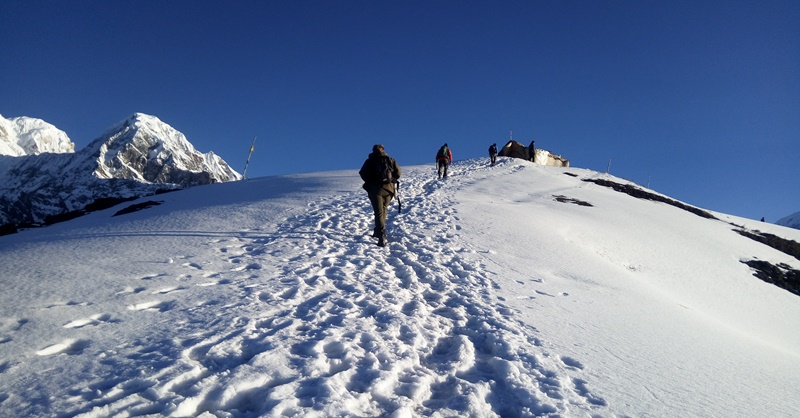
Way to Mardi Himal View Point- very close by view point
When preparing for the Mardi Himal Trek, it is important to pack wisely to ensure that you have everything you need for the trek. Here are some essential items to include in your packing list:
During the trek, expect to trek for around 5-6 hours per day, with some days being more challenging than others. The trail can be steep and rocky at times, so it’s important to take breaks and pace yourself accordingly. The altitude can also be a factor, so it’s important to acclimatize properly by ascending gradually and staying hydrated.
The accommodations along the trail are basic tea houses, which provide meals and a place to sleep. The food is generally simple but hearty, with options such as dal bhat (rice and lentil soup), noodles, and vegetables.
Overall, the Mardi Himal Trek is a rewarding and memorable experience, but it’s important to come prepared and have realistic expectations.
The Mardi Himal Trek is a relatively new trekking route in the Annapurna region of Nepal, but there are several tea houses and lodges available along the trail. Here’s what you can expect in terms of accommodation options and facilities during the trek:
Tea Houses:
The majority of accommodations along the Mardi Himal Trek are tea houses, which are basic lodges that offer a simple room with a bed, shared bathroom facilities, and communal dining areas. The tea houses are run by local families and provide a unique opportunity to experience the local culture and hospitality. The rooms may not be luxurious, but they are clean and comfortable, and provide a cozy retreat after a long day of trekking.
Facilities:
The tea houses generally have basic facilities such as shared bathrooms with squat toilets, running water, and a bucket shower. Hot water is available but may come at an extra cost. Electricity is available in most tea houses, but it may be limited and may not be available 24/7. Wi-Fi is also available in some tea houses, but it may be slow and unreliable.
Food:
The tea houses along the Mardi Himal Trek offer a variety of meals, including traditional Nepali dishes such as dal bhat (rice and lentil soup) and momos (steamed dumplings), as well as international options such as pasta and pizza. The food is generally simple but hearty and provides the energy needed for trekking. Most tea houses offer a set menu, but some also offer à la carte options. It’s important to note that the food is prepared fresh, so it may take some time to be served.
Water:
It’s important to stay hydrated while trekking, so it’s recommended to bring a reusable water bottle to refill along the trail. The tea houses sell bottled water, but it’s expensive and not environmentally friendly. It’s also possible to purify water using water purification tablets or a water filter.
The Mardi Himal Trek is considered a moderate trek, with an average daily trekking time of 5-6 hours. The trail is well-defined and not too steep, although there are some sections that require a bit of scrambling and hiking on narrow paths. The highest altitude reached on the trek is 4,500 meters, which is not too high for most trekkers. However, trekking at altitude can be physically demanding and requires a good level of fitness. It’s recommended to do some cardiovascular exercise and strength training before the trek, as well as acclimatize properly along the trail. Trekking experience is helpful, but not necessary.
Trekking in the Himalayas is a rewarding experience, but it’s important to take certain safety precautions and tips to ensure a safe and enjoyable journey. Here are some key safety considerations for trekking in the Himalayas:
By taking these safety precautions and tips, you can enjoy a safe and memorable trekking experience in the Himalayas.
The starting point of the Mardi Himal Trek is Kande, which is located approximately 20 kilometers (12.5 miles) from Pokhara. It takes about an hour to drive from Pokhara to Kande.
The total distance to walk during the Mardi Himal Trek depends on the specific itinerary and route chosen, but it typically ranges from 60 to 70 kilometers (37 to 43 miles). The trek usually takes around 7-10 days to complete, depending on factors such as pace, acclimatization, and side trips.
During the trek, you’ll typically walk around 5-7 hours per day, with some days being longer or shorter depending on the terrain and elevation gain. It’s important to be prepared for the physical demands of the trek, including steep ascents and descents, as well as the effects of altitude on your body. Proper training and acclimatization are key to ensuring a safe and enjoyable trekking experience.
Mardi Himal trek from Kathmandu during the autumn season(September to November)
The Mardi Himal Trek can be accessed from Kathmandu during the autumn season, which runs from September to November. The trek typically begins with a flight from Kathmandu to Pokhara, followed by a drive to Kande, the starting point of the trek.
During the autumn season, the weather in the Annapurna region is generally mild and dry, making it an ideal time for trekking. The temperature during the day ranges from 15-20°C (59-68°F) in the lower elevations and can drop to 0-5°C (32-41°F) at higher altitudes. The skies are usually clear and provide excellent views of the mountains and landscapes.
The Mardi Himal Trek from Kathmandu typically takes around 10-12 days, including travel time to and from Kathmandu. During the trek, you’ll pass through beautiful rhododendron forests, traditional Gurung villages, and stunning mountain vistas, including views of Machhapuchhre (Fishtail) mountain and the Annapurna range.
It’s important to be prepared for the physical demands of the trek, including steep ascents and descents, as well as the effects of altitude on your body. Proper training and acclimatization are key to ensuring a safe and enjoyable trekking experience.
While the Mardi Himal Trek is typically a 7-10 day trek, it is possible to do a shorter 3-day trek from Pokhara during the autumn season. The trek can be done as a loop, starting and ending in Kande and passing through the Australian Base Camp and Low Camp before reaching the Mardi Himal Base Camp, with stunning views of the surrounding mountains and landscapes along the way. The trek requires a moderate level of fitness and acclimatization, as you’ll be ascending to an altitude of over 4,000 meters (13,000 feet). It’s important to be properly equipped and prepared for the trek, including warm clothing and proper hiking gear.
The Mardi Himal trek is a popular and relatively short trek that offers stunning views of the Annapurna range. The trek typically takes four days and can be done during the autumn season, which is considered the best time to visit due to clear skies and mild temperatures.
Starting from the lakeside city of Pokhara, the trek takes you through picturesque villages and dense forests before reaching the high-altitude campsite at Mardi Himal Base Camp. Along the way, you’ll have the opportunity to take in breathtaking views of the Himalayas, including Machhapuchhre, also known as “Fishtail,” and Annapurna South.
Overall, the Mardi Himal trek is a great choice for those looking for a short but rewarding trekking experience in the heart of the Nepalese Himalayas.
The cost of the Mardi Himal trekking package during October and November can vary depending on the tour operator, the duration of the trek, and the level of services included.
On average, the cost for a 4-5 day Mardi Himal trek package can range from $300 to $600 per person, depending on the inclusions such as accommodation, meals, permits, guide and porter services, transportation, and other activities.
It’s important to note that prices can fluctuate depending on the season and the demand for trekking tours. During peak season, which includes October and November, the cost may be higher due to the popularity of the trek and the higher number of tourists.
To get the best value for your money, it’s recommended to research and compare different tour operators and packages, read reviews from previous clients, and negotiate the price if possible. Some popular tour operators offering Mardi Himal trekking packages include Nepal Hiking Team, Himalayan Glacier Trekking, and Adventure Great Himala
The Mardi Himal trekking route starts from the town of Kande and goes through several small villages, lush forests, and high-altitude campsites before reaching the Mardi Himal Base Camp. The best route for the Mardi Himal trekking can vary depending on the trekker’s preference and time available, but the following is the most popular and recommended route:
Day 1: Drive from Pokhara to Kande and trek to Australian Camp (2,050m)
Day 2: Trek from Australian Camp to Forest Camp (2,520m)
Day 3: Trek from Forest Camp to Low Camp (3,150m)
Day 4: Trek from Low Camp to High Camp (3,700m)
Day 5: Hike to Mardi Himal Base Camp (4,500m) and return to High Camp
Day 6: Trek from High Camp to Siding Village (1,750m)
Day 7: Trek from Siding village to Lumre and drive back to Pokhara
This route takes about 7 days to complete and offers stunning views of the Annapurna range, including Machhapuchhre and Hiunchuli. The route also takes you through beautiful forests, rhododendron forests, and charming villages where you can experience the local culture and traditions.
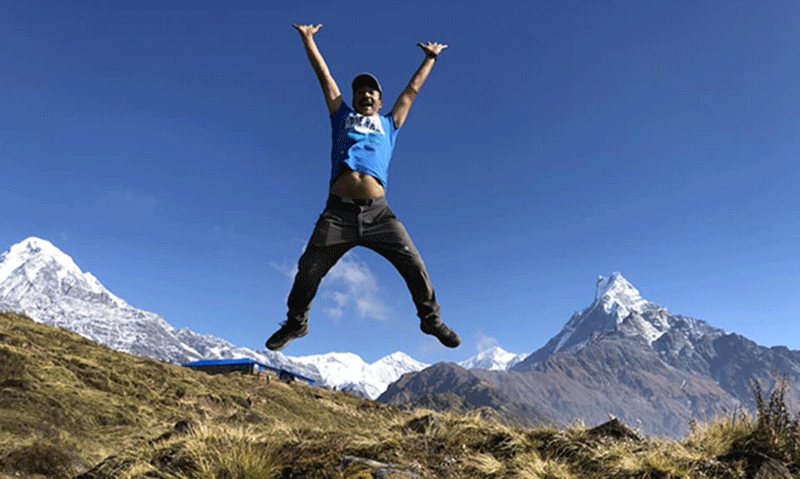
Beauty of Mardi Himal trek
Both the Mardi Himal trek and the Annapurna Base Camp trek are popular trekking routes in Nepal that offer stunning views of the Himalayas. Here are some differences between the two treks during the autumn season:
Difficulty level: The Mardi Himal trek is considered to be a moderate trek, while the Annapurna Base Camp trek is considered to be a more challenging trek due to its higher altitude and longer duration.
Crowd levels: During the autumn season, both treks can be quite crowded, but the Annapurna Base Camp trek tends to attract more tourists due to its popularity and reputation as one of the best treks in Nepal.
Scenery: Both treks offer spectacular views of the Himalayas, but the Annapurna Base Camp trek takes you closer to the Annapurna massif, while the Mardi Himal trek offers more panoramic views of the Annapurna range and Machhapuchhre.
Accommodation: The Annapurna Base Camp trek has more established trekking lodges and tea houses along the route, while the Mardi Himal trek has fewer options and may require camping at higher altitudes.
Cost: The cost for both treks can vary depending on the tour operator, duration of the trek, and level of services included, but generally, the Annapurna Base Camp trek is more expensive due to its popularity and longer duration.
The Mardi Himal trek with Poon Hill is a great choice for trekking during the autumn season in Nepal, which runs from September to November. During this time, the weather is dry and stable, with clear skies and mild temperatures, making it an ideal time for trekking.
The trek offers spectacular views of the Annapurna range and Machhapuchhre, as well as opportunities to explore local villages, forests, and high-altitude campsites. The autumn season is also a great time to witness the local culture and traditions, as many festivals take place during this time.
The Mardi Himal trek with Poon Hill usually takes about 10-12 days to complete, and trekking during the autumn season can be quite popular. It’s important to book your trekking package in advance and be prepared for some crowds on the trail. However, the stunning views and cultural experiences make it well worth it.
During the Mardi Himal trek, it’s important to eat a balanced and nutritious diet to maintain your energy levels and stay healthy. Here are some of the best foods to eat during the trek:
Dal Bhat: This is the staple food of Nepal and consists of rice, lentil soup, vegetables, and sometimes meat. It’s a great source of carbohydrates and protein and is often available in the tea houses along the trail.
Momos: These are popular Nepalese snacks, similar to dumplings, and are filled with vegetables or meat. They’re a great source of protein and can be a good option for a quick snack on the trail.
Chapati: This is a type of flatbread that’s often served with dal bhat and is a good source of carbohydrates and fiber.
Porridge: This is a good option for breakfast and is often served with milk and honey. It’s a great source of energy and will help keep you full for longer.
Fruits and Nuts: These are great options for snacks and can provide a quick burst of energy. Dried fruits and nuts are often available at tea houses, but fresh fruits may be harder to find on the trail.
It’s important to stay hydrated during the trek, so be sure to drink plenty of water and other fluids like tea and soup. Avoid drinking untreated water, and consider carrying a water purifier or purification tablets.
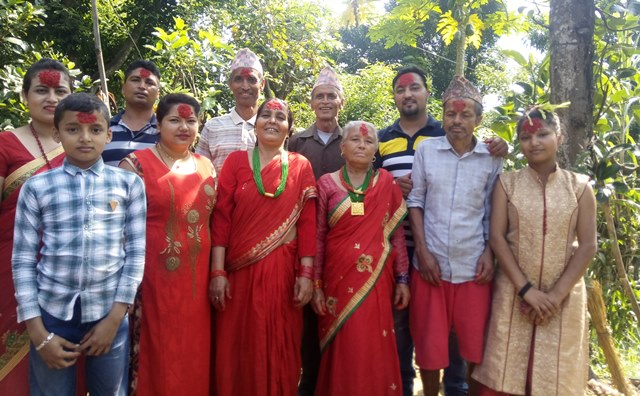
Tika day of Dasai festival in countryside area of Nepal.
October and November are peak festival seasons in Nepal, and there are several major festivals that are celebrated during this time. Some of the popular festivals celebrated in Nepal during October and November are:
Dashain: Dashain is the biggest and most important festival in Nepal, celebrated for 15 days in October. It symbolizes the victory of good over evil and is celebrated with family gatherings, feasting, and the exchange of gifts.
Tihar: Tihar, also known as the festival of lights, is a five-day festival celebrated in November. Each day of Tihar has a different significance, and the festival is marked by the lighting of diyas (oil lamps), the decoration of homes with garlands of marigold flowers, and the playing of music.
Chhath Puja: Chhath Puja is a four-day festival celebrated in October or November, mostly by the people in the Terai region of Nepal. It is dedicated to the Sun God and involves fasting, bathing in holy rivers, and offering prayers to the Sun.
Mani Rimdu: Mani Rimdu is a three-day festival celebrated in November by the Sherpa people in the Everest region of Nepal. It involves the performance of ancient Buddhist rituals, including masked dances, and is considered a time for spiritual renewal and purification.
Indra Jatra: Indra Jatra is a week-long festival celebrated in September or October in Kathmandu. It is dedicated to the Hindu god Indra and involves the display of the Kumari, the living goddess of Nepal, and the performance of traditional dances and music.
These are just a few examples of the many festivals celebrated in Nepal during October and November. The exact dates of these festivals may vary each year, so it’s always best to check with the local authorities or travel agencies for the most up-to-date information.
Mardi Himal Trekking with a guide is highly recommended, especially for those who are new to trekking or unfamiliar with the area. A local guide can provide valuable information about the trek, the culture, and customs of the local people, and can help ensure your safety during the trek. Here are some benefits of trekking professional with a guide: